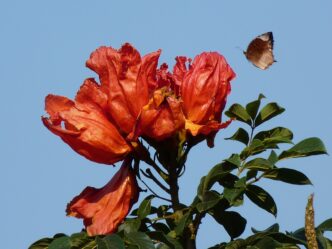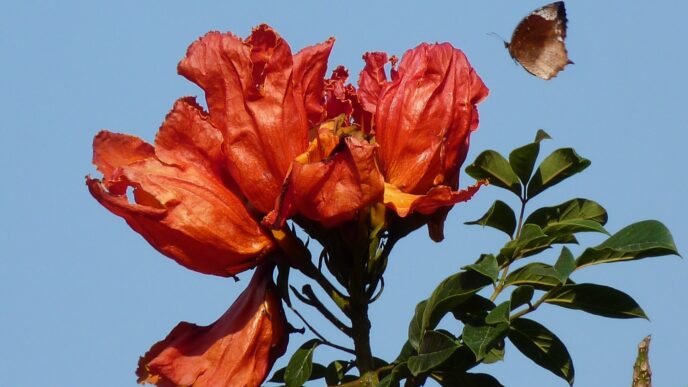A garden is not just a feast for the eyes, but a refuge where all the senses can be engaged. The vibrant colors of blooming flowers, the rustling of leaves in the breeze, and the soft touch of petals all contribute to an immersive sensory experience. However, what truly elevates a garden from beautiful to enchanting is its fragrance. A fragrant garden can transport you to a place of tranquility and happiness, where every breath is filled with delightful scents that soothe the mind and uplift the spirit.
Creating a fragrant garden involves carefully selecting plants that emit pleasant aromas throughout different seasons. Here are ten fragrant flowers to consider for your garden, each chosen for their unique scents and ability to create an inviting, aromatic atmosphere.
1. Roses
Roses are globally renowned for their symbolic meaning of love and elegance, with different varieties offering distinct fragrances. Notable varieties include ‘Gertrude Jekyll,’ which offers a classic, old-fashioned rose scent, ‘Mister Lincoln,’ known for its bold, spicy fragrance, and ‘Double Delight,’ featuring a sweet, fruity fragrance with a hint of spice. For roses to thrive, plant them in well-drained soil rich in organic matter. Roses love sunlight, requiring at least 6-8 hours of direct sun daily. Regular pruning is essential to maintain their health and shape, and deadheading spent blooms encourages continuous flowering.
2. Jasmine
Jasmine is famous for its sweet and exotic fragrance, which is a favorite for creating romantic atmospheres in gardens, patios, and outdoor spaces. The Star Jasmine (Trachelospermum jasminoides) offers clusters of fragrant white flowers, ideal for growing on trellises or fences, while Common Jasmine (Jasminum officinale) is known for its rich, heady scent. Jasmine thrives in full sun with some afternoon shade, and it prefers slightly acidic, well-drained soil. Regular watering is necessary but ensure the soil doesn’t become waterlogged. Pruning jasmine encourages more flowers and helps it stay manageable, especially on climbing supports like trellises.
3. Lavender
Lavender is known for its calming fragrance and vibrant purple blooms, making it an excellent choice for gardens, patios, and even indoor pots. Lavender’s fragrance is often used in perfumes, oils, and culinary dishes. For lavender to thrive, plant it in a sunny location that receives at least 6 hours of direct sunlight each day. It prefers slightly alkaline, well-drained soil. Lavender is drought-tolerant once established, so avoid overwatering, as this can lead to root rot. Pruning after flowering helps maintain its shape and encourages healthy new growth. Lavender needs space to grow, so plant it where it has room to spread out.
4. Gardenia
Gardenias are prized for their luxurious and intoxicating fragrance, with their creamy white blooms adding elegance to any garden. Gardenias thrive in slightly acidic soil, ideally with a pH between 5.0 and 6.0. They grow best in partial shade, particularly in regions with intense midday heat, as too much direct sunlight can scorch their leaves. Regular watering is essential, but avoid waterlogging. Mulching helps retain moisture around the roots. Gardenias benefit from fertilization using plant food formulated for acid-loving plants. Pruning helps maintain their shape and encourages airflow, reducing the risk of fungal diseases.
5. Oriental Lilies
Oriental lilies are known for their large, elegant blooms and bold fragrance, which becomes more pronounced in the evening. These lilies are particularly attractive in moonlit gardens. To thrive, Oriental lilies require well-draining soil that is slightly acidic to neutral. They prefer 6-8 hours of direct sunlight each day but can benefit from afternoon shade in hot climates. While they enjoy moisture, lilies don’t tolerate soggy soil. Water deeply but infrequently, and use mulch to retain moisture around the roots. Plant lily bulbs 4-6 inches deep, ensuring proper spacing for airflow. Fertilize with a balanced plant food, but be cautious not to over-fertilize. Taller varieties may need staking for support to keep the blooms upright.
6. Honeysuckle
Honeysuckle, a flowering plant that includes varieties like the climbing Japanese Honeysuckle (Lonicera japonica) and the compact Bush Honeysuckle (Lonicera spp.), thrives in full sun but can tolerate partial shade. It prefers well-drained, slightly acidic to neutral soil and requires consistent moisture, though it shouldn’t be waterlogged. Climbing varieties need support, such as a trellis or fence, and should be pruned regularly to maintain shape and encourage growth. Light feeding with balanced fertilizers in the spring helps promote healthy blooms.
7. Sweet Peas
Sweet Peas are another beautiful flowering option, preferring nutrient-dense, well-draining soil with a slightly alkaline to neutral pH. They enjoy full sun but can handle some partial shade in hotter climates. Sweet Peas need consistent moisture, but their soil should never be waterlogged. These plants require vertical support like a trellis or netting and should be spaced about 6–8 inches apart. Regular deadheading encourages continuous blooms, and a low-nitrogen fertilizer ensures that foliage doesn’t overwhelm flowering.
8. Peonies
Peonies, with their showy blooms, prefer well-drained, fertile soil with a slightly acidic to neutral pH and at least 6–8 hours of full sun each day. It’s essential to plant them at the correct depth—no more than 2 inches below the surface—to avoid stunted growth. Peonies need deep watering but should not have wet foliage to prevent fungal diseases. These plants require about 3 feet of spacing for proper air circulation. Light spring fertilization encourages growth, and deadheading after blooming will help maintain their appearance.
9. Daphne
Daphne, known for its fragrant flowers, prefers well-drained, slightly acidic to neutral soil and thrives in partial shade, especially in warmer climates. This plant requires careful watering, as it prefers well-drained soil and doesn’t tolerate overwatering. Daphne should be spaced at least 3 feet apart to promote healthy growth and air circulation. It benefits from light feeding with organic, balanced fertilizers, and minimal pruning is needed—only removing dead or damaged branches. Though cold-hardy, it requires extra protection in extremely cold climates to prevent damage.
10. Stock (Matthiola)
Stock (Matthiola incana) is a fragrant, colorful annual known for its large clusters of flowers in shades of pink, white, purple, and yellow. It thrives in full sun to partial shade and prefers well-drained, slightly alkaline soil. Stock plants should be spaced around 6–8 inches apart to allow for proper air circulation. They enjoy moderate moisture but are susceptible to root rot if the soil is too wet, so it is important to ensure the soil is well-draining.
Stock flowers are ideal for cooler temperatures and tend to bloom in early spring or fall, making them a perfect addition to gardens with mild weather. These plants can be grown from seeds, which should be sown in early spring or late summer, depending on the growing season. Deadheading spent flowers encourages a longer blooming period, and adding a balanced fertilizer can help support healthy growth and vibrant blooms.
Conclusion
When selecting flowering plants like Honeysuckle, Sweet Peas, Peonies, and Daphne, it’s essential to consider their unique preferences for sunlight, soil, and moisture conditions. By providing the right environment, including proper spacing, watering, and occasional pruning, these plants can thrive and offer beautiful blooms throughout the growing season. Whether you’re growing them for their fragrant flowers, vibrant colors, or lush greenery, each plant brings its own charm and value to the garden.





